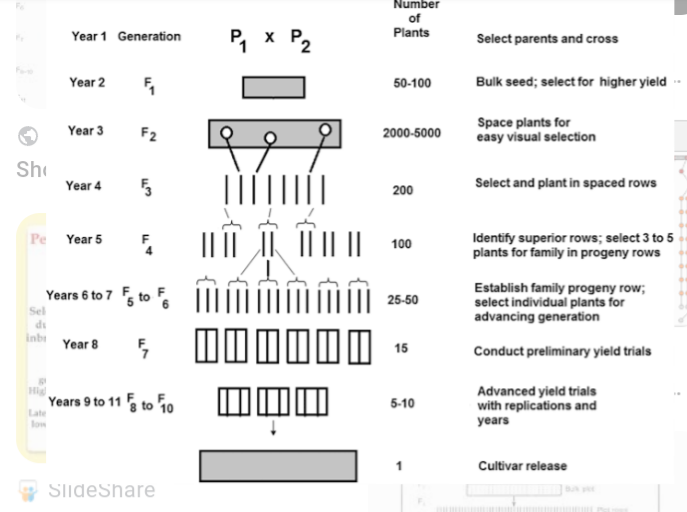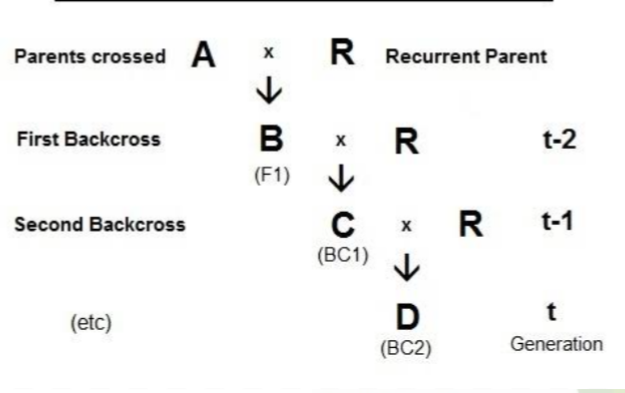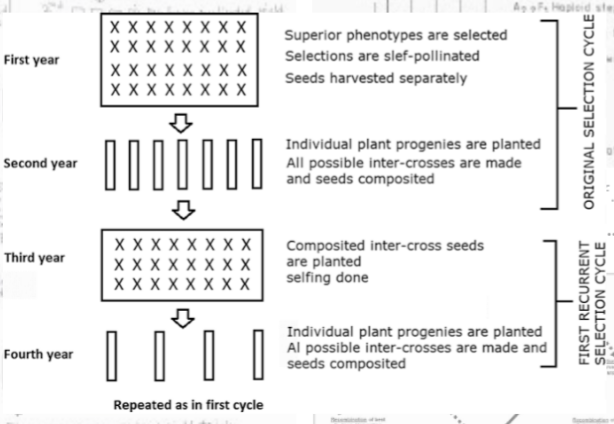The shortage of food supply to meet the need of human population is a great concern to the whole world. Local varieties of crops are low yielding, effert of pest and diseases, mining of soil nutrients without replacement, war or conflicts, etc are causes of food shortage. Therefore, plant breeders have developed improved varieties which possess various characteristics that can withstand problems that can cause crop failure.
Plant breeding is a conscious human effort needed to improve and develop new plants. These efforts are needed to satisfy human food need and Animal feed. The new plants that are developed are called CROP VARIETIES. When crop genotype are under experimentation (that is, when tested for acceptance or rejection,) they are referred to as LINES. The varieties grown by farmers is called CULTIVARS.
Genotype means genetic constitution of an individual.

By definition, plant breeding refers to purposeful manipulation of qualities in plants to create new varieties with a set of desired characteristics. The characters also called traits include plant hight, seed colour, fruits size, texture and taste, Yield increasing per land area, Resistance to pests and diseases, Adaptation to environmental stresses such as heat, drought, frost, and salty Soils, seedless varieties of fruits and vegetables etc.
The aim of plant breeding is to develop plants with improved characteristics so that they become more desirable agronomically and economically. Or to improve certain yield related character in crops
It is important for plant breeders to have understanding of the reproductive system of the plants he or she wants to work with. Some plants are autogamous (self pollinating) or allogamous (cross pollinating) in nature.
Objectives of plant breeding
The following are the major objectives of plant breeding:
To increase the crop yield.
To raise plants with desired characteristics.
To develop a disease-resistant crop.
To develop plants that can tolerate extreme environmental stress.
THE ROLE OF PLANT BREEDING IN NATIONAL DEVELOPMENT
1. Production of crops that gives increase yield per unit area
2. Production of crops that have definite improvement over the existing varieties
3. Production of crops that adapted to the needs of the grower and consumers.
4. Production of crops that give high quality yield
5. Production of crops that are resistant to insect pest and diseases
6. Production of crops that adapt to specific environment etc.
Two types of characters exist in plant breeding: qualitative and quantitative characters
QUALITATIVE CHARACTERS
These are traits that show mendelian in character (1:2:1 or 3:1). They are controlled by one or two pairs of gene. There phenotype in the second filial generation have close resemblance with the parent. Selection is faster when dealing with qualitative characters than when dealing with quantitative character. Because in qualitative characters, unfavourable genes can easily be seen and eliminated.
QUANTITATIVE CHARACTERS
It is also known as metric character. The characters are controlled by many genes. Such characters are agronomic in nature and are influenced by the environment. They segregate in the second filial generation. They are physiological in nature. For example, dry matter yield, and oil content in plants.
CONVENTIONAL AND NON CONVENTIONAL METHODS OF PLANT BREEDING
CONVENTIONAL METHOD
1. Self pollinated crops
2. Cross pollinated crops
METHODS OF BREEDING SELF POLLINATED CROPS
a) mass selection
b) pureline selection
c)Hybridization. This is further divided into
I) pedegree selection
II) bulk method
III) backcross method
METHODS OF BREEDING CROSS POLLINATED CROPS
a) mass selection
b) modified mass selection
c) recurrent selection
d) reciprocal recurrent selection
e) hybrid vans synthetic varieties
METHODS OF BREEDING SELF POLLINATED CROPS
1. PURELINE SELECTION
A pureline is the progeny of a single homogeneous self pollinated plant. Pureline selection is the random selection of large numbers of single plants from an original population of plant varieties that are genetically different. The selected single plants become the new varieties after considering characteristics such as earliness, seed size, disease resistant etc. A progeny test is carried out on the plant during which particular characteristics of interest are used to select the best line. Incase less variability occurs among plant samples, a disease epiphytotics can be introduced To eliminate undesirable plants. After selecting and isolating the best line, the remaining lines are isolated. The selected best lines are then put to replicated trials so as to compare them with the local checks. This will help determine the yield ability and agronomic performance of the selected best line.
2. HYBRIDIZATION : This is the process of making crosses within two plant parents. There are two types of crossing, inbreeding and outcrossing
INBREEDING: Inbreeding is the production of offspring from the mating or breeding of individuals or organisms that are closely related genetically.
OUTCROSSING: This is the breeding between two individual plants that are genetically different or genetically diverse.
Hybridisation is the method of producing new varieties of plants by crossing two individuals of different genotypes. It can be intraspecific if cross is done between two individuals of same species or it may be interspecific if cross is done between two individuals of different species. The divisions of Hybridization include:
a) BULK SELECTION
This is also called population method. This method involves the following steps
-identification of the varieties to use
-Cross the plant samples to check variability and obtain the first filial generation (F1)
-Grow the F1 seeds inorder to obtain the second filial generation (F2)
-Harvest in bulk a lot of the F2 plants. Obtain their seeds and plant them together again to obtain the third filial generation (F3).
-Continue planting the progeny seeds in the subsequent generations until about 97% homogenuity of the best line is achieved. After this, the best line is tested for comparative yield and the best line finally selected for registration as a new variety.
b) . PEDEGREE BREEDING
This is the breeding program that involves crossing the parent plants with the offspring plant. It is applied to self pollination crops only. The aim is to combine the desired gene from one or more genotype into a single outstanding individual called variety.
The procedure used in pedegree breeding involves the Selection of trusted parents that will be crossed to produce the offspring that is better off in many attributes than the parents.

c) BACKCROSS BREEDING ( or introgression breeding) METHOD
Backcross breeding method is used when a dominant variety exist within a locality lacks one or more desirable character such as disease resistance, large size seeds, is crossed with a variety that has the desirable character the dominant variety lacks . It is a cross between the first filial generation (F1) and either of the two parents (that is, the recurrent parents). The donor parent is usually selected because of its high degree character which is lacking in recurrent parent. For example, a high-yielding soybean can be crossed with a blight-resistant soybean to give progenies. All progeny that are still blight resistant are then crossed to their high-yielding parent. This is repeated over and over again by crossing back to the high-yielding parent, and selecting the blight-resistant progeny.

PROCEDURES FOR BACKCROSS BREEDING METHOD
-Select the parent
-make crosses between the two parents
-Make a backcross to the recurrent parents
CONDITIONS REQUIRED TO ACHIEVE SUCCESSFUL BACKCROSSING
1. There should be availability of satisfactory recurrent parent
2. A desired character should be noticed which must be retained after series of backcrossing
3.The recurrent parent must be reconstituted to a higher degree after the backcross in process.
ADVANTAGES OF BACKCROSSING
a. It is a step wise procedure for crop improvement without loosen anything.
b. Environment has no effect on this procedure
c. Rapid improvement is possible due to very low environmental effect
d. Progeny testing is not necessary
e. In terms of time and space, the method is very economical
DISADVANTAGES OF BACKCROSSING
a) . Ideal or perfect parent may not be found
b) Undesirable genes may be transferred to the new variety.
c) Hybridization has to be done for each backcross therefore more time is required.
d) Does not permit combination of genes from more than two parents.

METHODS OF BREEDING CROSS POLLINATED CROPS
Mass selection involves selecting from the genetic resources available in the population of plants. While recurrent selection, reciprocal recurrent selection and hybrid varsus synthetic varieties are types of Hybridization where new genetic resources are generated.
1. MASS SELECTION : This is an old breeding procedure of cross pollinated crops. Here, individual selection is used because, cross pollination are homogeneous and mixing of wide range genetic diversity is needed to maintain a vigorous population. Mass selection is based on phenotypic appearance both in qualitative and quantitative characters.
PROCEDURES FOR MASS SELECTION
– Large population of individual plants are selected based on their phenotype.
-Harvest as seeds are bulked without progeny test
-seeds are planted and selection done from seedling stage
-The selected plants should be tagged and allow to mature
-harvested seeds from matured tagged plants should be used for other generations
WAYS OF SELECTING IN MASS SELECTION
a. By rogging: used when undesirable plant exist in thepopulation
b. By tagging: used when desirable plant population is less than undesirable plant population
REASONS FOR MASS SELECTION
a. To increase the proportion of superior genotype in the population
b. Used to maintain varietal purity in existing cultivars or formation of new cultivars
c. Used to remove contamination from other seeds.
ADVANTAGES OF MASS SELECTION
a. It is simple and easy to carry out.
b. New varieties can be developed quickly
DISADVANTAGES OF MASS SELECTION
a. It is not effective in improving characters like yield
b. The breeding process is limited to the rate of genetic variability existing in the population
2. RECURRENT SELECTION: This is the selection that takes care of the deficiencies of mass selection. It involves reselection of generation after generation with interbreeding of selected individuals to provide for genetic recombinations.
It is a method of breeding used in both cross pollinated species and self pollinated species. But commonly used in cross pollinated species than in self pollinated species. It is a modified form of progeny selection.
The objectives of recurrent selection are:
a. To increase the genetic recombinations among lines derived from foundation plants
b. It is used for maintenance of genetic variability in the breeding population
c. To concentrate or increase the frequency of genes for a particular quantitative character in a population

TYPES OF RECURRENT SELECTION
a) Recurrent selection for phenotypes or simple recurrent selection
b) Recurrent selection for general combination abilities
c) Recurrent selection for specific combining abilities
d) Reciprocal recurrent selection.
ADVANTAGES OF RECURRENT SELECTION
a) It is a breeding method used in both cross pollinated and self pollinated species.
b) It is effective for only traits of high heritability.
c) No reduction in genetic variability occur in the outcome ( improved population produced). Therefore, future improvement can occur.
d) The breeder has opportunity of adding new germplasm during the procedure should the genetic base of the population become narrowed after selection cycles.
e) It is used to improve the frequency of desirable alleles for a character in a breeding population.
3.RECIPROCAL RECURRENT SELECTION (RRS)
Reciprocal recurrent selection (RRS) is also known as recurrent reciprocal half sib selection. It is a cyclical breeding procedure used to improve the cross of two populations from different heterotic groups by using both general and specific combining ability. In RRS procedure, two Population genotypes are usually evaluated in reciprocal crosses and the best genotypes of each population are selected and recombined to give rise to improved population crosses. This gives the reason why it is useful for improving two source population simultaneously. It is also useful for both specific combining abilities (SCA) and general combination abilities (GCA).
PROCEDURES FOR RECIPROCAL RECURRENT SELECTION
– one year, two source population A and B are taken and phenotypically superior plants are selected from each population and selfed
– Each of the selected plants from A is randomly mated with plants in B
– Self seeds are harvested separately and used for planting in the third year
– top crossed seed from each plant is harvested separately.
ADVANTAGES OF RECIPROCAL RECURRENT SELECTION
a) It is used for improvement of polygenic characters
b) It requires three seasons for completion of each cycle of selection
c) It is used for improving population for GCA and SCA for specific characters
d) selection is based on test Cross performance. etc
DISADVANTAGES OF RECIPROCAL RECURRENT SELECTION
a) It requires many recurrent cycles for population improvement
b) The method permit selfing which lead to losses of some genetic variabilities
c) The method is not used in development of new varieties.
4. HYBRID VARS SYNTHETIC VARIETIES
Hybrid varieties are variety produced by crossing two or more different Purelines inorder to produce superior progenies that contains the best traits of each of the parents.
Synthetic variety on the other hand is a variety developed by selecting a number of inbred lines which have good general combining ability (GCA), intercrossing them in all possible combinations and mixing the seeds of all the crosses conducted, in equal quantity. One of the advantages of synthetic varieties is for their hybrid vigour and for their ability to produce usable seed for succeeding seasons. Because of this, synthetic varieties are used in growing of many species of plants that undergo cross pollination like forage crops, Cocoa, alfalfa, cloves etc where pollination control is difficult, and expense prohibits the development or use of hybrid varieties. The lines that make up synthetic varieties include open pollination varieties, inbred lines, clones, population tested by GCA, etc.
TERMINOLOGIES
PLANT BREEDING : This is the science of improving or manipulating the heredity of the plant.
PROGENY : This is the next generation plant.
PROGENY TEST: Growing of selected single plants in progeny rows for ease of observation
LOCALCHECKS : These are commercial load l varieties
RECURRENT PARENTS: This is the parent adapted and accepted as being agronomically good but is lacking in one important character
DONOR PARENTS: This is the second parent which donate the pollen in the male plant.
HOMOGENEOUS : This is when an organism has identical gene. For example: BB or bb
HETEROGENEOUS : This is when an organism has two dissimilar gene. For example Bb.
PHENOTYPE: This is the outward appearance of a organism. That is, the way the genes expresses themselves. For example: brown seed coat,
HEREDITY: This is the transmission of potential traits of physical and other characteristics from parents to offspring
GENES: These are barriers of hereditary factors. The factors are information that expresses characteristics which are passed from parents through gametes to the offspring.
F1 GENERATION: This is the result obtained when two true breeding lines or varieties of contrasting characters are crossed.
